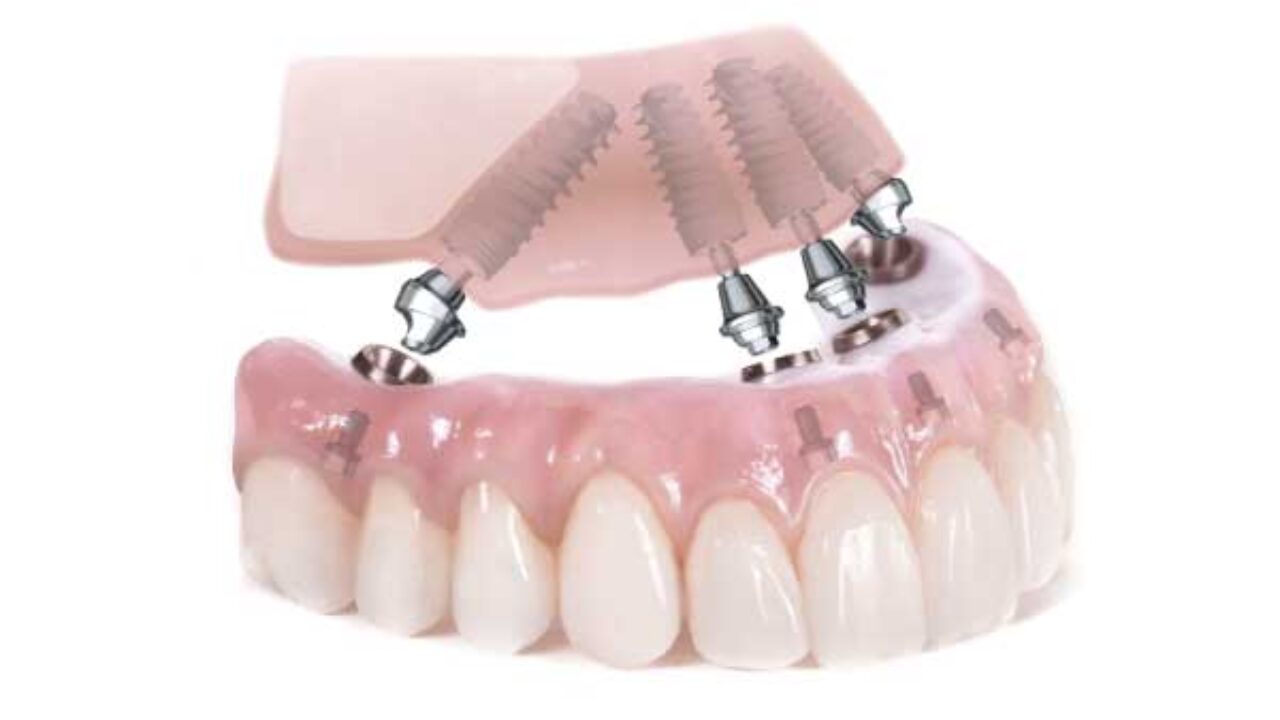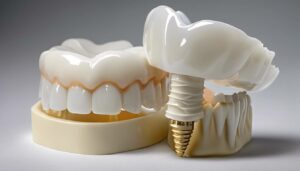
18 Apr Acrylic vs Porcelain Implants: A Comparison of Dental Implant Materials
When it comes to dental implants, two primary materials that regularly pop up are acrylic and porcelain. Both serve distinct purposes in the world of dental restorations, and depending on your specific needs, one may be a more suitable option than the other.
Acrylic Implants:
- Also called acrylic resin or “all acrylic” implants, these are most frequently used as a temporary solution before a permanent restoration can be applied.
- Their lighter weight and non-corrosive nature make them a good fit for bone healing after tooth removal. They also prove useful in situations where the patient might require an intermediate solution during complex dental procedures.
Acrylic implants provide quick and effective solutions but may not offer the long-term durability desired for permanent replacements.
Porcelain Implants:
- Porcelain implants are ceramic-based and known for their remarkable ability to closely resemble natural teeth in terms of both appearance and texture.
- The inherent strength of porcelain makes it ideal for long-term permanent restoration. Dentists often recommend porcelain implants when a patient desires a replacement that mirrors the look, feel, and sturdiness of natural teeth.
Understanding the Distinctions
Each type has its own unique set of benefits and potential drawbacks. It is essential to take these distinctions into account when determining which material will best serve your restorative needs.
Choosing between acrylic and porcelain implants isn’t always straightforward. Each person’s oral health requirements vary, making one material more suitable than the other. Affordability, durability, aesthetics, functionality, and fitting circumstances all play significant roles in this determination.
For example, if you have suffered tooth trauma necessitating immediate extraction, an acrylic implant might be used as part of an interim response until bones fully heal and are prepared for the permanent restoration phase. Conversely, if you’re looking for an aesthetic outcome, especially in visible areas of your mouth such as the front teeth, then a durable and natural-looking porcelain implant would likely be recommended to blend seamlessly with surrounding teeth, ensuring a harmonious smile.
Intrigued? Well, we’re just scratching the surface here. Let’s dig deeper into both implant materials to uncover the full spectrum of nuances involved in utilising each for dental restorations.
The Advantages and Disadvantages of Acrylic Implants
Acrylic implants offer benefits that make them an appealing option for some patients.
Advantages
Affordability: One of the clear advantages of acrylic implants is their affordability, making dental implant procedures more accessible to a broader range of individuals who may not have considered them otherwise due to cost implications.
Lightweight: Another notable advantage of acrylic implants is their lightweight nature, which can be particularly beneficial for individuals who are more sensitive to having foreign objects in their mouth or those who require complex dental work.
It’s important to note that while these advantages are significant, there are also some drawbacks to consider when it comes to acrylic implants.
Disadvantages
Less Natural Appearance: While effective in restoring dental function, the natural appearance of acrylic implants, especially for front teeth, may be compromised as they may not look as natural as porcelain.
Durability: When considering acrylic implants compared to porcelain, durability plays a significant role. Acrylic implants are generally less durable and tend to wear faster than porcelain counterparts. This reduced durability could be a concern for individuals seeking long-term solutions for their dental restoration needs.
Understanding the trade-offs between the distinct advantages and limitations of acrylic implants provides crucial insights for those considering this type of dental restoration. Now, let’s explore the unique features and characteristics of porcelain implants in detail to make an informed comparison.
Pros and Cons of Porcelain Implants
When it comes to aesthetics, porcelain implants stand out for closely resembling natural teeth. The material has an organic quality that makes it blend seamlessly with your existing teeth, ensuring a more genuine-looking smile. Compared to acrylic implants, which may have a slightly artificial appearance, porcelain can provide a more authentic visual result.
Durability
Porcelain’s strength and durability make it an attractive option for many patients. It is highly resistant to wear and staining, offering a substantial lifespan that can outweigh potential upfront costs due to its longevity.
Durability is undoubtedly one of the significant benefits of porcelain implants. The robust nature of porcelain means it is highly resistant to fractures and stains, making it an excellent choice for those who prioritise long-lasting results. The ability of porcelain to maintain its appearance over time can be very appealing compared to other materials.
Consider how this could impact your everyday life. With porcelain implants’ resilience against wear and tear, you won’t have to stress about daily activities that could impact them. This level of security offers peace of mind and confidence in your dental investment.
Cost
A notable consideration when it comes to porcelain dental implants is the associated cost. Generally, these implants are pricier than their acrylic counterparts, sometimes presenting a considerable upfront investment. It’s essential to weigh the initial expense against the long-term benefits to determine if they align with your dental and financial goals.
Fracture Risk
Another factor to consider is the risk of fracture or chipping inherent in porcelain implants. While they boast impressive strength, there is still a higher likelihood of fractures compared to acrylic alternatives. This risk emphasises the importance of diligent oral care practises and mindfulness regarding activities that may put excessive pressure on the implant.
Despite the higher upfront cost and potential fracture risk, patients willing to invest in high-quality aesthetics and long-term durability might find that porcelain implants provide excellent value in the grand scheme of oral health and overall well-being.
Aesthetics: Porcelain vs. Acrylic Implants
When it comes to your tooth replacements, considering how they look and feel is just as important as their functionality. Nobody wants teeth that look artificial. Porcelain implants are designed to look incredibly lifelike, mimicking the natural translucency of real teeth and seamlessly blending in with your remaining natural teeth—huge advantages for individuals who prioritise aesthetics. The ability of porcelain implants to mimic the natural surface texture and coloration results in a remarkably authentic smile.
These implants come remarkably close to the appearance of natural teeth, offering patients a high-quality option that looks just like the real thing. When light passes through these implants, it interacts with the material much like it would with natural enamel, giving off a lifelike radiance. Patients can enjoy the confidence that their dental implants are virtually indistinguishable from their natural teeth, providing an aesthetically pleasing solution.
Just like artists carefully blend colours to achieve realism in paintings, dental technicians painstakingly craft porcelain implants to match the precise shade, shape, and size of each patient’s existing teeth, ensuring they seamlessly integrate with the rest of their smile.
On the other hand, while acrylic implants have made significant strides in aesthetic improvement, they may not reach the same level of realism as porcelain due to slight differences in their composition. Their inability to authentically replicate the luminescence of natural teeth may make them less appealing to those seeking an option that blends flawlessly with their original dentition.
Ultimately, when choosing between porcelain and acrylic dental implants, considering which material offers you the most lifelike appearance is a key factor. It’s essential to discuss your aesthetic goals with your dentist to help guide your decision-making process and ensure your new smile meets your expectations.
In weighing the pros and cons of dental implant materials, durability and longevity are paramount factors affecting your choice. Let’s explore how these materials compare in terms of long-lasting performance.
Durability and Longevity: Acrylic vs. Porcelain
When it comes to your dental implants, the durability of the material is probably one of your top concerns. It’s essential to choose a material that can last without degrading over time. Now, let’s take a closer look at how acrylic and porcelain implants compare in terms of wear, stain resistance, and overall longevity.
Both porcelain and acrylic materials possess unique characteristics that determine their durability and longevity. Porcelain implants are lauded for their exceptional strength and resistance to wear, making them a prime choice for individuals seeking long-term solutions. They are known to endure the rigours of daily use, maintaining their structure and appearance with proper care. This longevity is particularly evident when it comes to resisting staining, ensuring that your implants retain their brightness for years to come.
On the other hand, acrylic implants may display signs of wear and tear more readily. Their susceptibility to scratches, discolouration, and general deterioration over time may lead to a less resilient solution compared to porcelain alternatives. This could manifest as the need for more frequent replacements, potentially adding additional costs and inconvenience in the long run.
To put it in perspective, imagine porcelain implants as sturdy rocks standing the test of time, weathering all conditions admirably while maintaining their original splendour. Meanwhile, acrylic implants might be akin to softer substances that succumb to unavoidable forces more easily.
The Takeaway:
Porcelain: Known for exceptional wear resistance and resilience to staining.
Acrylic: May be prone to wear, staining, and require more frequent replacement than porcelain counterparts.
Cost Analysis: Acrylic and Porcelain Implants
When faced with the decision of dental implant materials, it’s crucial to consider the cost of each dental implant option. Initially, acrylic implants may appear more appealing due to their lower price. However, a comprehensive review is necessary. While acrylic implants are typically less costly than porcelain, patients should approach this decision with foresight. Long-term costs must be weighed. Although porcelain implants require a higher initial investment, their durability and longevity can make them more cost-effective over time by reducing the need for frequent replacements and ongoing maintenance.
Let’s envision this scenario: Patient A chooses an acrylic implant due to its lower upfront cost but needs a replacement after a few years due to wear or damage. Meanwhile, Patient B selects porcelain implants, which endure over time without necessitating constant maintenance or replacements. Ultimately, Patient B incurs fewer expenses.
It’s important for patients to seek advice from an experienced dental implant dentist who can provide well-informed guidance when making a decision. An experienced implant dentist can assist patients in balancing initial costs with the anticipated lifespan and maintenance demands of each type of implant. By adopting a proactive stance and evaluating long-term costs, patients can make an informed choice that aligns with both their immediate budget and long-term oral health needs.
In summary, acrylic implants are known for being more affordable but may not offer the same level of durability and natural appearance as porcelain implants. Porcelain implants, on the other hand, are highly durable, stain-resistant, and closely mimic the natural look of teeth. However, they tend to be more expensive. It is important to consult with your dentist to determine which option is best suited for your individual needs.
If you are considering having a dental implant procedure, then why visit us in Kirrawee, Sutherland Shire for a free implant consultation. Here our experienced implant dentist will take a look your mouth and discuss your treatment options Dental Implant page or call our reception on (02) 8544 8607.



